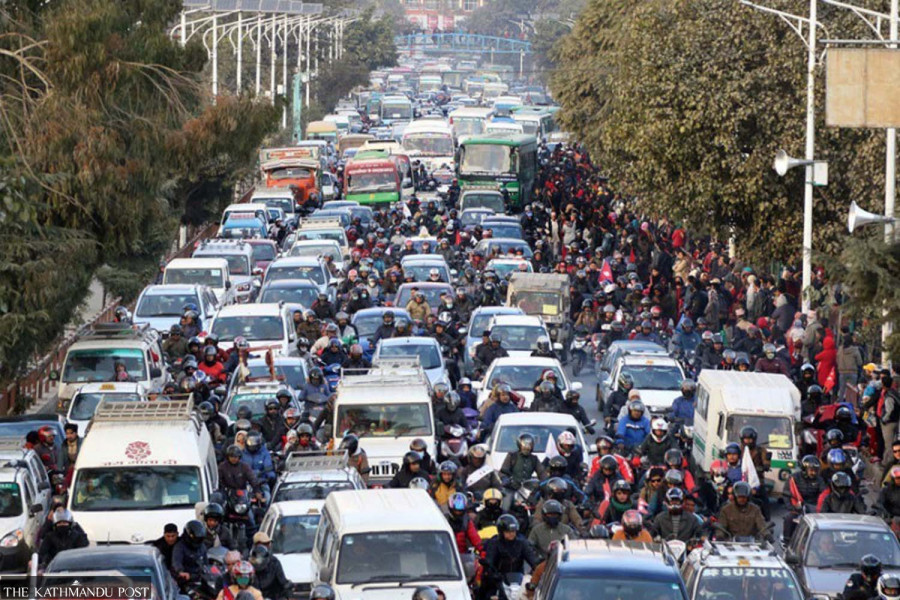
On Monday, Srijan Paudel left his home at Taukhel in Nagarjun Municipality at around 8:30am, carrying meals for his brother and soup for his sister-in-law, who recently gave birth at KIST Medical College in Gwarko. He took public transport and by the time he reached the hospital, it was 12:30pm, he said.
He was stuck in traffic jams in numerous places—Sitapaila, Kalanki, Kalimati, Tripureshwar, Thapathali, and Koteshwar—before facing the gridlock at the Gwarko intersection.
“The meal we had prepared for our brother and sister-in-law had become cold,” said Paudel, 37, a maths teacher at a private school.
Kathmandu Valley on Monday, from morning to late afternoon, saw traffic jams at numerous places, with Gwarko, which has become notorious for gridlocks of late, being the worst.
Sanotsh Sigdel, a law practitioner, took to Twitter to complain about the traffic congestion on Monday. “Gwarko Traffic is completely a mess now!” he wrote at 12:06pm. “Stuck here for the last 30 minutes!”
Traffic police said since it was a Monday, people in large numbers flocked to Shiva temples (Mondays in the Nepali month of Shrawan are considered especially auspicious for Shiva worship). In addition, the main opposition CPN-UML organised a protest rally protesting price hike and the government’s functioning that caused traffic snarls.
Paudel wondered what if there was an emergency situation and he had to arrange blood for his sister-in-law. “Luckily, that situation did not arise, but I dreaded a lot,” he told the Post.
Like Paudel, for Anita Thapa, it took more than an hour to reach her office from Satdobato to Putalisadak on Monday.
“I was stuck in a jam for nearly half an hour at Satdobato… then at Thapathali, Maitighar, and Singha Durbar. It was like ages before I reached office,” said Thapa, 32, who works at an education consultancy at Putalisadak. “I had scheduled an appointment with a client at 10am, but I was more than an hour late.”
It usually takes around 25 minutes to reach the office on usual days, she said.
The Valley’s traffic has become a nightmare for daily commuters of late, with roads teeming with vehicles whose numbers have risen sharply.
Experts say Valley’s roads are not sufficient to sustain the rising number of vehicles, and when there are protest rallies, traffic goes haywire, and Monday was just a case in point.
According to Kathmandu Valley Traffic Police Office, the number of vehicles that ply the Valley roads at present is 1.75 million. Just a year ago, traffic police data showed the number to be 1.4 million.
Deputy Inspector General Mira Chaudhari, who is the chief of the Kathmandu Valley Traffic Police, gives three reasons for Monday’s jams—many people were out on the roads headed for temples, on and off rains which forced two-wheeler users to stop at several places, and the political rally.
“There are traffic jams on other days also, but it is a fact that the number of vehicles plying Valley’s roads is really high,” said Chaudhari. “The current road infrastructure cannot sustain the vehicles. And incidents like festivals like Monday or a political rally can really cause gridlocks.”
According to a report of the Kathmandu Valley Traffic Police Office prepared in 2016, if all the vehicles in Kathmandu Valley were to be queued bumper to bumper, they would form a line longer than the total length of roads in the Valley. The traffic report states the total road length is 4.5 million feet, whereas the single queue of all the vehicles in the Valley would cross 7.2 million feet.
“The number of vehicles in the Valley has been rising steadily and if this trend continues, there will be a day when we will drive out of our homes, but will remain stuck on the roads without being able to move an inch for hours and hours,” said Suman Meher Shrestha, senior urban planner. “The road length has remained the same while the vehicle number is rising.”
Kathmandu, the federal capital, does not have a single flyover, while most of the traffic lights that can help regulate the flow of vehicles do not function.
According to traffic police, there are traffic lights at 53 different places in the Valley but only a few work properly. In most of the busy intersections, traffic police guide the vehicles, and on Monday it was a tough day for them.
Experts say while solutions like flyovers are not possible overnight, installing traffic lights in many places and keeping them operational can help address the Valley’s traffic woes to some extent.
“If we can synchronise traffic lights, nearly 50 percent of traffic jams can be solved,” said Jay Sankar Sharma, engineering head of the Valley Traffic Police Office. “But our task is limited to regulating traffic and enforcing road rules. The infrastructure part falls under the Department of Roads, and other local bodies.”
Haphazard parking is yet another bane of the Valley, causing traffic congestion in many places, especially where the roads are narrow.
Chaudhari says if parking can be managed, it would also help ease traffic movements.
“We had held serious consultations with the Kathmandu Metropolitan City about the tendency among business complexes of using their basements for some other purposes while forcing their clients to park vehicles on the road or roadside,” said Chaudhari. The City has taken initiatives to address this issue. Hopefully, once resolved, this will also help ease the traffic flow to some extent.”
Urban planners say there are multiple flaws in the Valley that lead to traffic chaos.
“There is an immediate need to encourage mass transport systems which can reduce the use of small vehicles, both private and public, thereby giving a relief from traffic jams,” said Shrestha. “Also haphazard parking needs to be discouraged and floyevers should be built. I don’t think the authorities are paying attention to these traffic jams which in the long run are going to emerge as a huge headache.”













